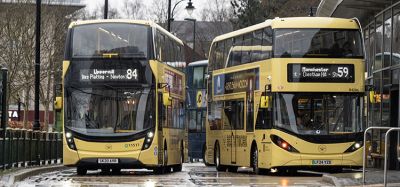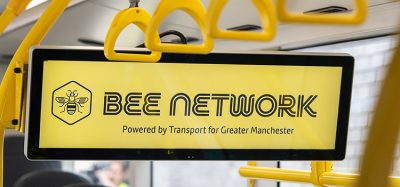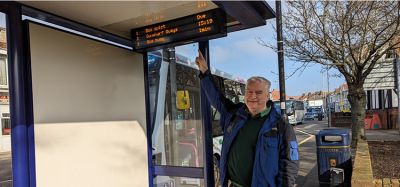Inter-modal Real-time Passenger Information and Managed Transfer Availability in Public Transport
- Like
- Digg
- Del
- Tumblr
- VKontakte
- Buffer
- Love This
- Odnoklassniki
- Meneame
- Blogger
- Amazon
- Yahoo Mail
- Gmail
- AOL
- Newsvine
- HackerNews
- Evernote
- MySpace
- Mail.ru
- Viadeo
- Line
- Comments
- Yummly
- SMS
- Viber
- Telegram
- Subscribe
- Skype
- Facebook Messenger
- Kakao
- LiveJournal
- Yammer
- Edgar
- Fintel
- Mix
- Instapaper
- Copy Link
Posted: 9 August 2007 | Stefan Gemperli, International Sales Manager, Siemens VDO Automotive AG (Schweiz) | No comments yet
To make local and regional public transport more attractive, passenger information is one of the critical success factors. Unlike dynamic real-time passenger information at stops, inter-modal in-vehicle dynamic passenger information that includes information on available transfers at next stops is still an exception.
Based on the VDV-453 real-time interface, Siemens VDO has successfully put into operation an installation in Switzerland and is now advancing this solution on a larger scale with another Swiss transport association. This article elaborates on the solution approach and the underlying core technology before moving on to describing the first implementation in the heartland of Switzerland. The last section of the article gives an overview of the most recent development stage, and provides an outlook for future applications.
To make local and regional public transport more attractive, passenger information is one of the critical success factors. Unlike dynamic real-time passenger information at stops, inter-modal in-vehicle dynamic passenger information that includes information on available transfers at next stops is still an exception. Based on the VDV-453 real-time interface, Siemens VDO has successfully put into operation an installation in Switzerland and is now advancing this solution on a larger scale with another Swiss transport association. This article elaborates on the solution approach and the underlying core technology before moving on to describing the first implementation in the heartland of Switzerland. The last section of the article gives an overview of the most recent development stage, and provides an outlook for future applications.
To make local and regional public transport more attractive, passenger information is one of the critical success factors. Unlike dynamic real-time passenger information at stops, inter-modal in-vehicle dynamic passenger information that includes information on available transfers at next stops is still an exception.
Based on the VDV-453 real-time interface, Siemens VDO has successfully put into operation an installation in Switzerland and is now advancing this solution on a larger scale with another Swiss transport association. This article elaborates on the solution approach and the underlying core technology before moving on to describing the first implementation in the heartland of Switzerland. The last section of the article gives an overview of the most recent development stage, and provides an outlook for future applications.
To make local and regional public transport more attractive to a large potential group of users, and thus more competitive, passenger information is one of the critical success factors. While dynamic real-time passenger information at stops has become a widely accepted standard, inter-modal in-vehicle dynamic passenger information that includes information on available transfers at next stops is not yet common.
Based on the VDV-453 real-time interface which forms one of the standards underlying the CEN Standard Interface for Real-Time Information (SIRI), Siemens VDO has successfully put into operation a real-world installation in Switzerland. The company is now advancing this solution on a larger scale with another Swiss transport association.
Solution approach
Studies show that topical information influences passengers’ perception of how long they have to wait for their next bus or tram. This is not only valid for the beginning of a journey, but also plays a significant role during the trip. Therefore, operation of public transport is perceived as more reliable and more convenient.
Hence, system integrators such as Siemens VDO have been striving to provide local public transport authorities with means to enhance in-vehicle information in such a way that passengers learn in real-time about available transfers at upcoming stops (and not only after they have reached the stop). A consequence of this is that transport authorities must be able to guarantee the transfer by ordering the receiver vehicles to wait for the incoming feeder vehicles.
Although this concept is generally termed ‘transfer protection’ in the public transport industry jargon, we prefer to refer to it as Managed Transfer Availability (MTA). The MTA concept aims at making the highest number of planned transfers available to the passenger.
To achieve this, an approach comprising of two steps has been chosen;
- Within a pre-defined time slot, the system automatically orders the receiver vehicles to wait for the feeder vehicles.
- As soon as this time slot has lapsed, the system warns the dispatcher in the control centre that from now on, the decision is his to keep the receiver vehicle waiting.
Therefore, any technical solution has to make adequate and dedicated information instantly available to passengers and drivers alike and yet must ensure that securing a reasonable number of transfers does not lead to slowing down local public transport at a network level. This is even more important when not only a single public transport authority is involved, but different operators at local, regional and even national levels.
Core technology
The core technology behind the solution implemented by Siemens VDO is the VDV-453 real-time interface which forms part of the basis of the SIRI that has been recently defined by the European Committee for Standardisation (CEN 15531). The Swiss National Railways (SBB) dubbed their SIRI implementation project ‘CUS.’.
SIRI is defined by the CEN as a communication layer which defines common procedures for requesting and exchanging public transport data, hence an interface between control centres of Automatic Vehicle Monitoring Systems (AVMS) or AVMS with these functions.
Figure 1 illustrates the basic set-up of this interface.
The scope of this interface is described by the CEN as a system architecture to exchange traveller information data between public transport operators or multimodal operators about time schedules, network events or waiting time.
According to the CEN, the objectives of SIRI are five-fold:
- To provide real-time service information to passengers;
- To provide information to journey planners;
- To facilitate transfers for passengers;
- To manage both fleet and network;
- To enable general business communication.
First implementation by Siemens VDO
Fully functional inter-modal real-time passenger information has been implemented by Siemens VDO in the Swiss city of Zug and its surrounding area, which is situated approximately 30 kilometres south of Zurich in the heartland of Switzerland.
This catchment area is mainly served by the regional bus authority Zugerland Verkehrsbetriebe (ZVB) and by the Stadtbahn Zug, a regional light rail system operated by the SBB. In this setting, the Stadtbahn vehicles act as feeders and the ZVB buses as receivers. In the light rail vehicles, passengers are not only informed of the actual departure times of the buses waiting at the next stop, but also of the impending departures of regional and national trains at the next train station.
This highly innovative solution has been jointly implemented by Siemens VDO, Zugerland Verkehrsbetriebe and the Swiss National Railways.
Latest implementation
Siemens VDO is currently implementing a very advanced Automatic Vehicle Location and Control (AVLC) system for the Zürcher Verkehrsverbund (ZVV) which serves the greater Zurich Area and is Switzerlands largest transport association.
Unlike the above mentioned system previously implemented in the Zug area, the AVLC for ZVV will provide not only train passengers with the actual bus departure times, but also bus passengers with real-time information on regional and national train departures. Therefore, passengers in all feeder vehicles will learn of all transfers available to them at the next stop, regardless of whether this is a city bus, a regional bus, a regional light rail train or a national train.
This inter-modal real-time approach will be the first of its kind that is technically capable to provide public transport users with seamless travel information along their entire travel chain. Before they even leave their home or office, users will have access to topical travel information via the Internet or handheld mobile devices. Once they have reached a bus stop or a train station, they are informed on all actual departure times at a given point in time. Both electronic information signs and smaller devices can act as information media. And as soon as they have boarded their public transport vehicle – be it a bus, a tram, a regional light rail or a national train – they are kept updated in real-time on all actual departures at the next stop as well as on all currently available transfers. Where feasible, they are presented with travel alternatives in case of network events such as significant delays or partial network congestions.
In-vehicle inter-modal real-time passenger information
In the system implemented for ZVV, all in-vehicle passenger information is displayed on the Multi Functional Display (MFD). This component displays topical information in a location-dependent sequence of specific screens.
The underlying display strategy is based on segmentation. The meaning of this is two-fold; firstly, it means that every stretch between two stops is fragmented into three so-called ‘path segments’. Secondly, while the vehicle is at a stop, the time is fragmented into three so-called ‘time segments’.
The idea behind the segmentation is that path 1 and path 3 as well as time 1 and time 3 are the important segments, while both path 2 and time 2 are fillers in between. The system automatically omits segments that cannot be executed entirely and stretches other segments so that no pauses occur. For every segment, a layout or sequence of layouts can be configured.
The individual layouts are described in Table 2.
Potentialities
Apart from enhancing travellers’ convenience, this inter-modal real-time passenger information solution enables transport authorities to manage and utilise their transport infrastructure more effectively:
- In case of network disturbances, for example, travellers can be advised to use those parts of the network that are still functioning by providing them with up-to-date travel recommendations.
- The inter-modal real-time passenger information interface is not limited to local or regional public transport. Indeed, it can provide information on all kinds of transportation, even planes. Thus, seamless travel information in real-time from the door of your home to the boarding gate of your airport no longer remains a utopian idea.






References
All information presented in this article is derived from the following sources; Siemens VDO Automotive AG (Schweiz) project documents and CEN Report N1830 of WG3 to the 36th Plenary Meeting of CEN/TC 278 in Sevilla by Convenor Jean-Laurent Franchineau, March 22, 2003 (http://www.nen.nl/cen278).








